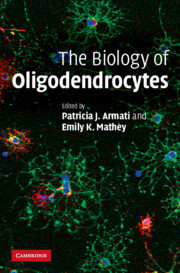Book contents
- Frontmatter
- Contents
- Preface
- Contributors
- 1 CNS oligarchs; the rise of the oligodendrocyte in a neuron-centric culture
- 2 Comparative biology of Schwann cells and oligodendrocytes
- 3 Control of oligodendrocyte development and myelination in the vertebrate CNS
- 4 Molecular organization of the oligodendrocyte and myelin
- 5 The genetics of oligodendrocytes
- 6 Immunobiology of the oligodendrocyte
- 7 Oligodendrocytes and disease: repair, remyelination and stem cells
- 8 Glial progenitor cells and the dynamics of the oligodendrocyte and its myelin in the aged and injured CNS
- 9 Oligodendroglial pathology in multiple sclerosis
- 10 Glutamate receptors, transporters and periventricular leukomalacia
- References
- Index
- Plate section
10 - Glutamate receptors, transporters and periventricular leukomalacia
Published online by Cambridge University Press: 05 August 2012
- Frontmatter
- Contents
- Preface
- Contributors
- 1 CNS oligarchs; the rise of the oligodendrocyte in a neuron-centric culture
- 2 Comparative biology of Schwann cells and oligodendrocytes
- 3 Control of oligodendrocyte development and myelination in the vertebrate CNS
- 4 Molecular organization of the oligodendrocyte and myelin
- 5 The genetics of oligodendrocytes
- 6 Immunobiology of the oligodendrocyte
- 7 Oligodendrocytes and disease: repair, remyelination and stem cells
- 8 Glial progenitor cells and the dynamics of the oligodendrocyte and its myelin in the aged and injured CNS
- 9 Oligodendroglial pathology in multiple sclerosis
- 10 Glutamate receptors, transporters and periventricular leukomalacia
- References
- Index
- Plate section
Summary
INTRODUCTION
Glutamate is the major excitatory neurotransmitter in the central nervous system (CNS). Glutamate exerts its role by activating ionotropic (Dingledine et al., 1999) and metabotropic glutamate receptors (Conn and Patel, 1994). Ionotropic glutamate receptors are ligand-gated ion channels consisting of α-amino-3-hydroxyl-5-methyl-4-isoxazole-propionate (AMPA), N-methyl-d-aspartate (NMDA), and kainate receptors. Metabotropic glutamate receptors are not ion channels, but rather G-protein-coupled receptors that activate biochemical cascades that can indirectly influence ion channels. Glutamate transporters are responsible for regulating the concentration of glutamate in the vicinity of synaptic and extrasynaptic glutamate receptors (Tzingounis and Wadiche, 2007). Excessive accumulation of extracellular glutamate causes prolonged activation of glutamate receptors resulting in excitotoxicity (Lipton and Rosenberg, 1994). High levels of glutamate cause an excessive influx of calcium into the cytosol via glutamate receptors coupled to ion channels, resulting in the pathological activation of a number of enzymes including phospholipases, endonucleases and proteases, such as calpain. Increased glutamate levels also result in mitochondrial dysfunction (Choi, 1988). Excitotoxicity is a common pathway of injury in many neurological diseases leading to neuronal cell death. Excitotoxicity has also been implicated in oligodendrocyte death in disorders of cerebral white matter, including periventricular leukomalacia (PVL).
PERIVENTRICULAR LEUKOMALACIA
Periventricular leukomalacia (PVL) is the major brain pathology, in long-term survivors of prematurity. Approximately 5–10% of babies born with a birth weight of less than 1500 g develop cerebral palsy. Nearly 5500 new cases of cerebral palsy in premature infants are diagnosed each year in the United States.
- Type
- Chapter
- Information
- The Biology of Oligodendrocytes , pp. 186 - 201Publisher: Cambridge University PressPrint publication year: 2010



